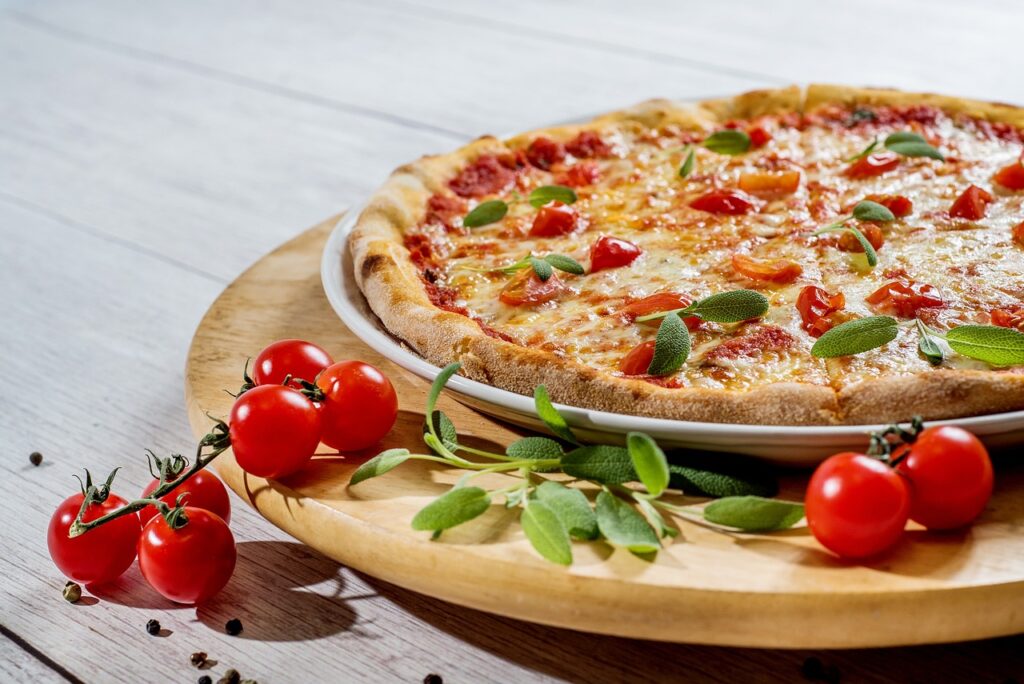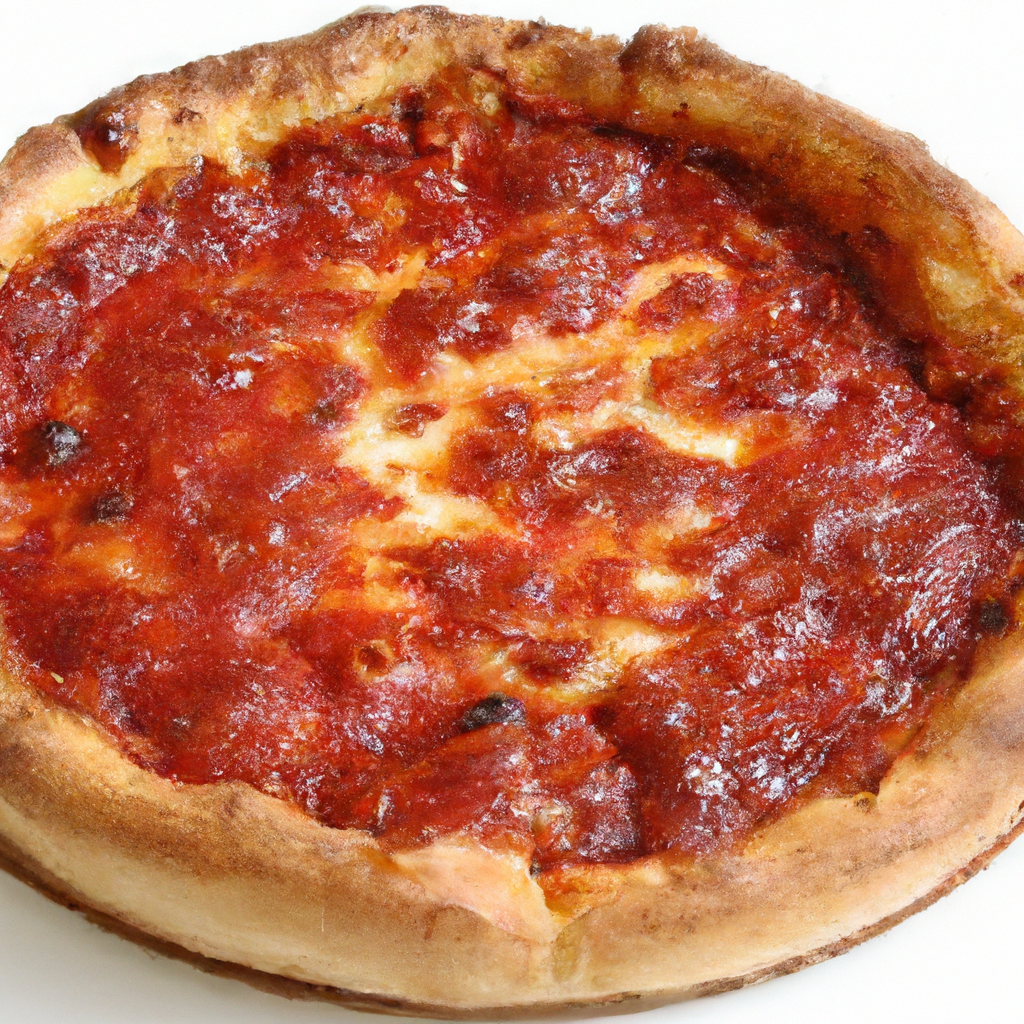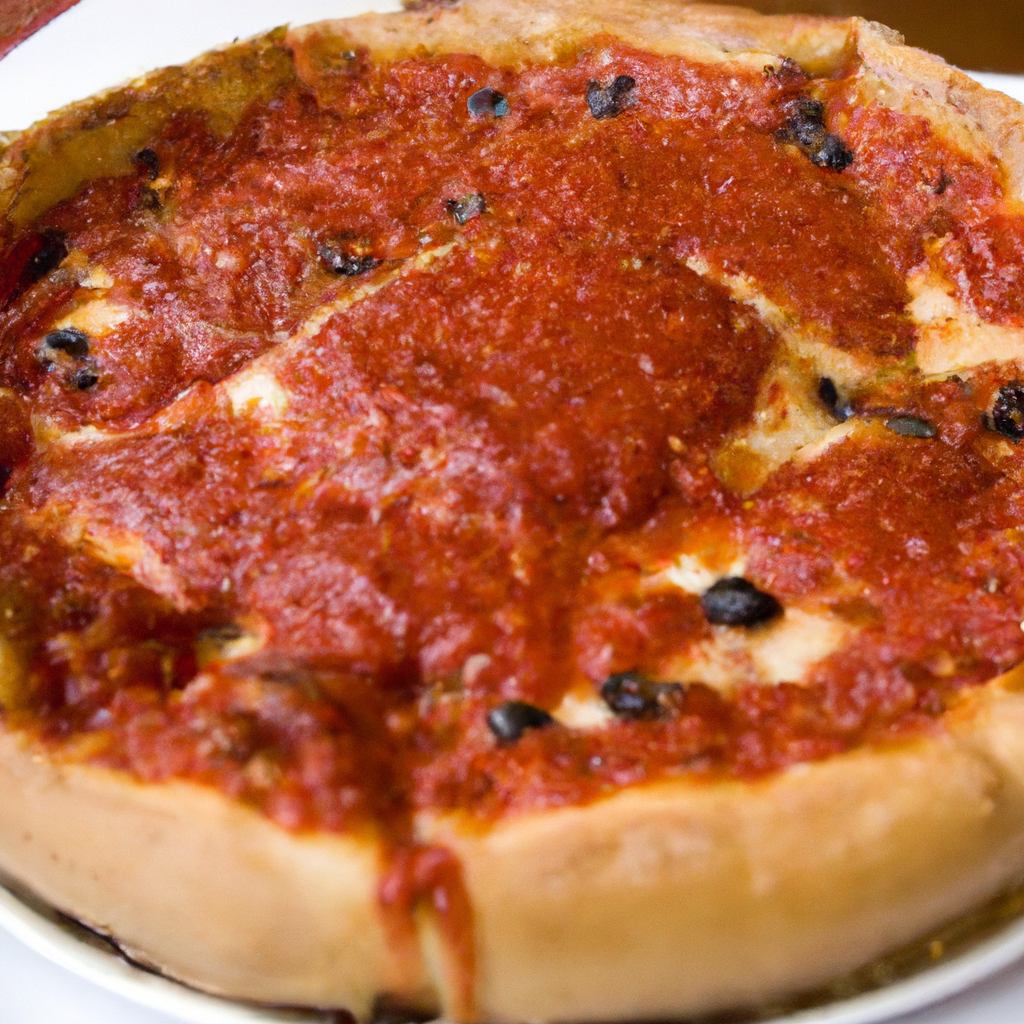Craving a slice of pizza but not sure which style to go for? Look no further! In this article, we’ll satisfy your curiosity by exploring the key differences between Chicago deep-dish and Sicilian pizza. Get ready to tantalize your taste buds as we take you on a delicious journey through these two iconic pizza styles. Whether you’re a fan of thick, cheesy crusts or crave the perfect balance of toppings and dough, we’ve got you covered. So grab a napkin and get ready to learn all about the mouth-watering distinctions between Chicago deep-dish and Sicilian pizza!

Crust
When it comes to pizza, the crust is an essential component that can make or break the entire experience. Both Chicago deep-dish and Sicilian pizzas have unique crusts that add to their distinctiveness.
Thickness
One noticeable difference between these two styles lies in the crust’s thickness. In Chicago deep-dish pizza, the crust is remarkably thick, almost resembling a pie crust rather than a traditional pizza base. It is sturdy and can hold up the weight of the generous toppings and gooey cheese. On the other hand, Sicilian pizza typically has a thick, yet fluffy crust. It strikes a balance between a doughy texture and a light interior, offering a satisfying bite.
Texture
The texture of the crust also differs between Chicago deep-dish and Sicilian pizzas. Chicago deep-dish pizza boasts a buttery and flaky crust that provides a delightful contrast to the savory fillings inside. It adds a pleasant crunch, especially at the edges. Conversely, Sicilian pizza crust has a soft and airy texture, thanks to its higher yeast content. This lighter texture allows the toppings to shine and complements the overall eating experience.
Ingredients
When it comes to the ingredients used in the crust, both styles of pizza utilize basic components such as flour, water, yeast, and salt. However, Chicago deep-dish pizza tends to incorporate cornmeal or semolina into the dough, giving it a slightly grainy texture and a nutty flavor. This addition adds an extra layer of complexity to the crust. Sicilian pizza, while also using similar base ingredients, often includes olive oil in the dough mixture. This addition contributes to the crust’s characteristic lightness and subtle hint of olive flavor.
Shape and Size
The shape and size of a pizza play a crucial role in its overall presentation and eating experience. Both Chicago deep-dish and Sicilian pizzas have distinct characteristics that set them apart in terms of form and diameter.
Form
Chicago deep-dish pizza, true to its name, is baked in a deep, round pan or skillet. The dough is pressed up along the sides of the pan, creating a high edge that forms a bowl-like structure to hold the ingredients. This form allows for generous layering of toppings and plenty of gooey cheese, resulting in a truly indulgent pizza experience. On the other hand, Sicilian pizza is typically baked in a rectangular pan. The dough is stretched and pressed into the pan, creating a thicker crust that extends to the edges. This shape allows for easier division into square or rectangular slices, perfect for sharing.
Diameter
When it comes to diameter, the two pizza styles also differ significantly. Chicago deep-dish pizzas are typically smaller and more personal in size, with diameters ranging from 9 to 12 inches. This smaller size is ideal for containing the thick and heavy toppings without compromising structural integrity. In contrast, Sicilian pizzas are usually larger in diameter, often measuring around 16 to 18 inches. The larger size makes it perfect for feeding a group of people or for enjoying leftovers the next day. These variations in size cater to different dining preferences and occasions.
Toppings
Beyond the crust, the toppings play a crucial role in determining the flavor profile and overall appeal of a pizza. Chicago deep-dish and Sicilian pizzas have their own distinctive combinations and approaches when it comes to toppings.
Traditional Toppings
Both Chicago deep-dish and Sicilian pizzas offer a range of traditional toppings to satisfy various taste preferences. Classic options like pepperoni, mushrooms, onions, and bell peppers can be found on both styles of pizza. However, each style also has its own unique selection of toppings that tie into its regional flavors and culinary traditions.
Cheese
Cheese plays a fundamental role in any pizza, and both Chicago deep-dish and Sicilian pizzas shine in this regard. Chicago deep-dish pizzas are known for their generous amount of mozzarella cheese. The abundance of cheese creates a gooey layer that perfectly complements the buttery crust. Sicilian pizza, on the other hand, often features a combination of mozzarella and a slightly sharper cheese such as Pecorino Romano or Parmigiano-Reggiano. This blend provides a tangy and savory undertone that enhances the overall flavor.
Sauce
The sauce used in both styles of pizza adds a burst of flavor and moisture to the toppings and dough. In Chicago deep-dish pizza, the tomato sauce is typically made with whole, peeled tomatoes that are seasoned with a blend of spices like basil, oregano, and garlic. This sauce is often chunky and has a robust, tangy taste that complements the richness of the cheese and toppings. Sicilian pizza, on the other hand, tends to use a smoother tomato sauce that is lighter in flavor but still provides a necessary balance to the toppings and crust.
Vegetables
The vegetable toppings on Chicago deep-dish and Sicilian pizzas differ slightly in terms of variety and preparation. Chicago deep-dish pizzas often feature a medley of vegetables such as green bell peppers, onions, mushrooms, and black olives. These toppings are typically diced or sliced and form a colorful and flavorful layer on top of the cheese. Sicilian pizza, on the other hand, may showcase a wider range of vegetables, including artichokes, sun-dried tomatoes, and fresh basil leaves. These toppings are often placed on the pizza in a more intact form, offering a burst of freshness and visual appeal.
Meat
For meat lovers, both Chicago deep-dish and Sicilian pizzas offer an array of delicious options. Chicago deep-dish pizzas are often packed with hearty meat toppings such as Italian sausage, ground beef, and pepperoni. These toppings add a savory and robust flavor to every bite. Sicilian pizza, on the other hand, may feature a wider variety of cured meats, including prosciutto, salami, or capicola. These thinly sliced meats add a delicate and savory touch to the pizza, elevating its flavor profile.
Cooking Method
The cooking method employed for each style of pizza influences its texture, taste, and overall presentation. Understanding the baking time and oven used is crucial to achieving the perfect Chicago deep-dish or Sicilian pizza.
Baking Time
Chicago deep-dish pizza requires a longer baking time compared to other pizza styles. This is due to its thick crust and generous amount of toppings. The average baking time for a Chicago deep-dish pizza ranges from 30 to 45 minutes at a moderate temperature. This extended baking period allows the dough to cook thoroughly and the cheese to melt and become bubbly, resulting in a well-cooked and satisfying pizza. Sicilian pizza, on the other hand, generally requires a shorter baking time of around 20 to 30 minutes. The emphasis for Sicilian pizza is on achieving a golden-brown crust while ensuring the toppings are heated through.
Oven
The choice of oven also contributes to the final result of the pizzas. Chicago deep-dish pizzas are traditionally cooked in a deep-dish pizza pan or skillet, which helps retain heat and gives the crust its distinctive texture. These pans are often made of heavy-duty materials such as cast iron or steel, allowing for even heat distribution and excellent oven spring. Sicilian pizzas are typically baked in rectangular pans, which provide ample space for the dough to rise and develop its characteristic lightness. These pans are often made of aluminum or steel, allowing for efficient heat transfer and a well-cooked crust.

Origins
The origins of Chicago deep-dish and Sicilian pizzas can be traced back to their respective regions. Understanding their roots helps to appreciate the cultural and historical significance of these iconic pizza styles.
Chicago Deep-Dish
Chicago deep-dish pizza has its roots in the city of Chicago, Illinois. It was first created in the 1940s at Pizzeria Uno, owned by Ike Sewell and Ric Riccardo. The duo wanted to develop a pizza that stood out from the thin-crust pizzas commonly found in the city. They devised a recipe that involved a buttery crust, chunky tomato sauce, generous cheese, and toppings that were layered in reverse order compared to traditional pizzas. This unique approach to pizza-making quickly gained popularity and became synonymous with the city of Chicago.
Sicilian
Sicilian pizza, as the name suggests, originates from the island of Sicily in Italy. It draws influence from the traditional sheet pan pizzas found in Sicilian bakeries, where the dough is pressed into large rectangular pans and topped with a variety of ingredients. This style of pizza-making has been passed down through generations, with each family adding their own twist to the recipe. Sicilian pizza is deeply ingrained in Sicilian culture and has become a beloved culinary tradition both on the island and beyond.
Popularity
Both Chicago deep-dish and Sicilian pizzas have gained popularity not only in their respective regions but also across the globe. Each pizza style has its own unique fan base and appeal.
Region
Chicago deep-dish pizza is undoubtedly a beloved icon of the Windy City. It is cherished by locals and tourists alike as a must-try culinary experience when visiting Chicago. The deep-dish pizza culture has become deeply intertwined with Chicago’s identity and has sparked numerous debates about the best deep-dish pizzerias in the city. Sicilian pizza, on the other hand, is popular not only in Sicily but also in other parts of Italy, particularly in the south. Its popularity has spread internationally as well, with many pizzerias worldwide offering Sicilian-style pizzas.
Recognition
Chicago deep-dish pizza has gained significant recognition and acclaim over the years. It has been featured on various food shows, and numerous Chicago Deep-Dish Pizza Festivals celebrate this iconic pizza style. People from all over the world come to Chicago to savor a slice of its famous deep-dish pizza. Sicilian pizza, while perhaps not as globally recognized, has its own devoted following. The distinct flavors and textures of Sicilian pizza have caught the attention of pizza enthusiasts, and it is often regarded as a highlight of Sicilian cuisine.
Texture
The texture of a pizza is a critical aspect of the dining experience. Both Chicago deep-dish and Sicilian pizzas offer unique textures that contribute to their deliciousness.
Crust
The crust texture of Chicago deep-dish pizza is rich and buttery, with a perfect balance of crispness and tenderness. The thick layers of dough create a substantial foundation that holds up the toppings and prevents sogginess. The outer edges of the crust are typically golden and slightly crunchy, providing a satisfying contrast to the softer interior. In contrast, the crust of Sicilian pizza is airy and light. The higher yeast content and longer rising time result in a dough with a pillowy and tender texture. This lighter texture allows the crust to absorb the flavors of the toppings and provides a pleasant chewiness.
Filling
The filling texture of each pizza style is also distinct. Chicago deep-dish pizza offers a more substantial and dense filling due to the thick layers of cheese, sauce, and toppings. The cheese melts and blends with the sauce, creating a gooey and luxurious texture that is uniquely satisfying. The layering of ingredients ensures that each bite is bursting with flavors and textures. Sicilian pizza, on the other hand, has a more even distribution of toppings and cheese, resulting in a harmonious and balanced filling. The toppings are not as thick as in a deep-dish pizza, but they still provide a substantial bite, complementing the lightness of the crust.
Eating Style
The style in which a pizza is eaten can vary depending on personal preferences and cultural norms. Chicago deep-dish and Sicilian pizzas lend themselves to different eating styles.
Uses Utensil
Given its thick and hearty nature, Chicago deep-dish pizza is often enjoyed using utensils. The combination of a sturdy crust, generous toppings, and gooey cheese makes it difficult to eat by hand without making a mess. Using a fork and knife allows you to savor each layer of the pizza, ensuring that you get a mouthful of all the delicious components. This eating style also slows down the eating process, allowing you to fully appreciate the flavors and textures of the deep-dish pizza.
Handheld
Sicilian pizza, on the other hand, is often enjoyed as a handheld treat. Its rectangular shape and lighter toppings make it easier to pick up and hold, making it a convenient option for eating on the go or at casual gatherings. The light and airy crust of Sicilian pizza holds its shape well, allowing for easy handling without losing any toppings. Many people enjoy the tactile experience of eating Sicilian pizza with their hands, relishing the combination of flavors in each bite.

Serving Order
The order in which a pizza is layered and sliced can affect the overall eating experience. Both Chicago deep-dish and Sicilian pizzas have their own distinct serving orders.
Layering
Chicago deep-dish pizza follows a unique layering order compared to other pizza styles. The crust is first pressed into the deep-dish pan, forming a thick and sturdy base. Next, the ingredients are added in reverse order compared to traditional pizzas with the cheese forming the bottom layer. This helps to form a protective barrier between the crust and the sauce, preventing it from becoming too soggy. The sauce is then added on top of the cheese, followed by the toppings and additional cheese. This layering order ensures that each bite is packed with flavorful cheese and toppings.
Slicing
Sicilian pizza is typically sliced into square or rectangular pieces, a departure from the traditional triangular slices commonly associated with pizza. This slicing style allows for equal distribution of toppings and facilitates easy serving and sharing. The rectangular shape of Sicilian pizza lends itself well to this slicing method, with each piece offering a balanced combination of crust, cheese, sauce, and toppings. This method also adds a visual appeal to the pizza, showcasing the colors and textures of each slice.
Variations
Both Chicago deep-dish and Sicilian pizzas have their own unique variations that offer exciting twists on the traditional styles.
Different Styles
Chicago deep-dish pizza has seen various creative interpretations throughout the years. Some pizzerias put their spin on the classic recipe by adding innovative ingredient combinations or experimenting with the crust’s texture and flavor. For example, stuffed deep-dish pizzas feature a second layer of dough on top of the toppings, creating a “stuffed” effect. This variation allows for additional fillings such as spinach, mushrooms, or even more cheese. Another variation is the use of alternative crusts, such as a cornmeal or whole wheat crust, which adds a different dimension of flavor and texture.
Sicilian pizza is also open to adaptations and variations. While the classic Sicilian pizza features a simple topping arrangement, some variations incorporate additional ingredients to create unique flavor profiles. For instance, a Sicilian pizza with seafood toppings, such as shrimp or clams, showcases the bounty of the sea and pays homage to Sicily’s coastal culture. Other variations may include locally sourced ingredients or regional cheeses to give the pizza a distinct identity.
Adaptations
As with any popular food, Chicago deep-dish and Sicilian pizzas have inspired adaptations in different parts of the world. Beyond their original regions, people from all over the world have sought to recreate these beloved pizza styles in their own kitchens or local pizzerias. While the authenticity may vary, these adaptations help spread the love for Chicago deep-dish and Sicilian pizzas to a wider audience and highlight the versatility and enduring appeal of these pizza styles.
In conclusion, both Chicago deep-dish and Sicilian pizzas offer unique experiences that are worth exploring. From the thickness and texture of the crust to the variations in toppings and cooking methods, these two pizza styles have distinct characteristics that set them apart. Whether you prefer the indulgence of a deep-dish pizza or the lightness of a Sicilian slice, both styles showcase the artistry and creativity that goes into crafting a delicious pizza. So, next time you’re in the mood for pizza, consider trying either a Chicago deep-dish or a Sicilian pizza and embark on a culinary adventure that will delight your taste buds.

